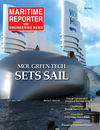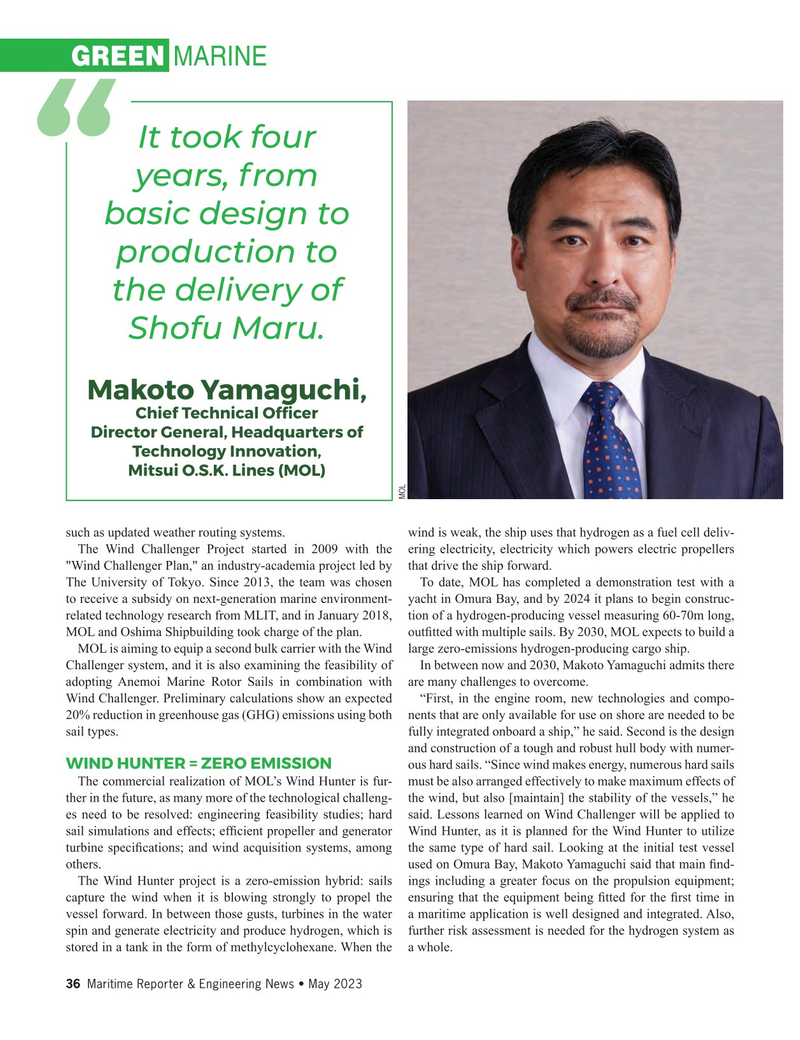
Page 36: of Maritime Reporter Magazine (May 2023)
Green Ship Technologies
Read this page in Pdf, Flash or Html5 edition of May 2023 Maritime Reporter Magazine
GREEN MARINE
It took four years, from basic design to production to the delivery of
Shofu Maru.
Makoto Yamaguchi,
Chief Technical Of? cer
Director General, Headquarters of
Technology Innovation,
Mitsui O.S.K. Lines (MOL)
MOL such as updated weather routing systems. wind is weak, the ship uses that hydrogen as a fuel cell deliv-
The Wind Challenger Project started in 2009 with the ering electricity, electricity which powers electric propellers "Wind Challenger Plan," an industry-academia project led by that drive the ship forward.
The University of Tokyo. Since 2013, the team was chosen To date, MOL has completed a demonstration test with a to receive a subsidy on next-generation marine environment- yacht in Omura Bay, and by 2024 it plans to begin construc- related technology research from MLIT, and in January 2018, tion of a hydrogen-producing vessel measuring 60-70m long,
MOL and Oshima Shipbuilding took charge of the plan. out? tted with multiple sails. By 2030, MOL expects to build a
MOL is aiming to equip a second bulk carrier with the Wind large zero-emissions hydrogen-producing cargo ship.
Challenger system, and it is also examining the feasibility of In between now and 2030, Makoto Yamaguchi admits there adopting Anemoi Marine Rotor Sails in combination with are many challenges to overcome.
Wind Challenger. Preliminary calculations show an expected “First, in the engine room, new technologies and compo- 20% reduction in greenhouse gas (GHG) emissions using both nents that are only available for use on shore are needed to be sail types. fully integrated onboard a ship,” he said. Second is the design and construction of a tough and robust hull body with numer- ous hard sails. “Since wind makes energy, numerous hard sails
WIND HUNTER = ZERO EMISSION
The commercial realization of MOL’s Wind Hunter is fur- must be also arranged effectively to make maximum effects of ther in the future, as many more of the technological challeng- the wind, but also [maintain] the stability of the vessels,” he es need to be resolved: engineering feasibility studies; hard said. Lessons learned on Wind Challenger will be applied to sail simulations and effects; ef? cient propeller and generator Wind Hunter, as it is planned for the Wind Hunter to utilize turbine speci? cations; and wind acquisition systems, among the same type of hard sail. Looking at the initial test vessel others. used on Omura Bay, Makoto Yamaguchi said that main ? nd-
The Wind Hunter project is a zero-emission hybrid: sails ings including a greater focus on the propulsion equipment; capture the wind when it is blowing strongly to propel the ensuring that the equipment being ? tted for the ? rst time in vessel forward. In between those gusts, turbines in the water a maritime application is well designed and integrated. Also, spin and generate electricity and produce hydrogen, which is further risk assessment is needed for the hydrogen system as stored in a tank in the form of methylcyclohexane. When the a whole.
36 Maritime Reporter & Engineering News • May 2023
MR #5 (34-49).indd 36 5/2/2023 8:46:47 AM

 35
35

 37
37
